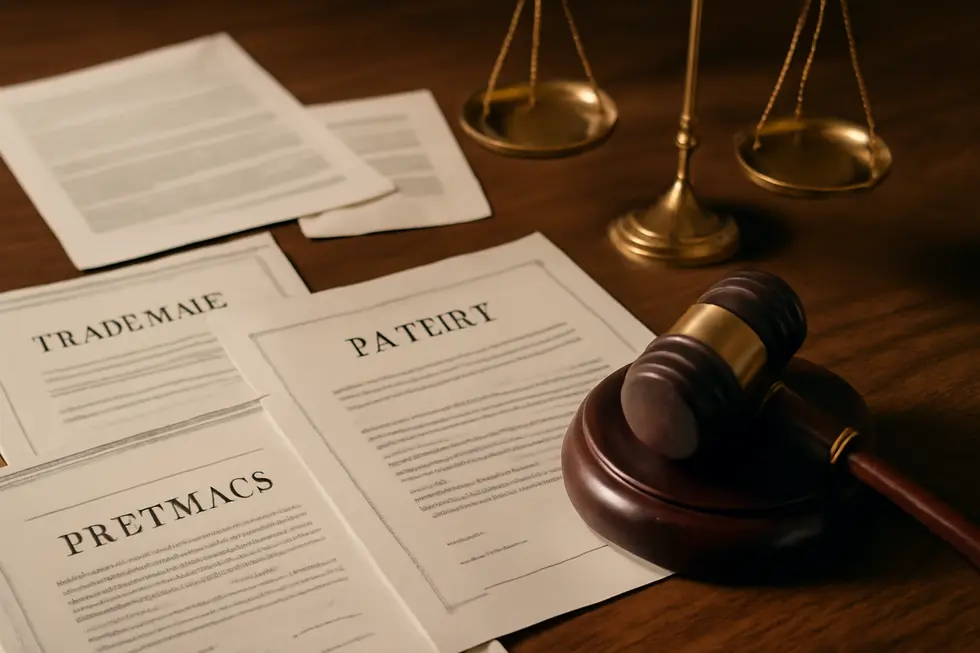Introduction
Intellectual property and patents are vital components in securing a business’s innovations and creative assets. Knowing the distinctions and how each protects different elements of your business can guide strategic decisions and help safeguard your competitive edge. This article clarifies the definitions and scope of IP versus patents, explores the legal protection mechanisms behind each, and illustrates practical implications with business examples. Each chapter builds a comprehensive understanding to empower business owners in leveraging these legal tools effectively.
Tables of Contents
Chapter 1: Understanding the Scope and Definition of IP vs Patent
- How Technological Innovations Shape the Boundaries of IP and Patent Protection
- Economic Dynamics Shaping the Distinction Between Patents and Broader IP Rights
- Geopolitical Dynamics Shaping the Global Landscape of IP and Patent Protection
- How Society Shapes the Perception and Role of IP and Patents
Chapter 2: Legal Protection Mechanisms in IP vs Patent
- Balancing Technical Precision and Broad Innovation: The Technological Scope of Patent Rights within IP Protection
- Economic Dynamics of IP and Patent Protections: Strategic Value, Investment Returns, and Market Influence
- Cross-Border Challenges and Jurisdictional Nuances in Enforcing Patents and Intellectual Property Rights
- Navigating Disclosure, Duration, and Public Interest in Patent and Intellectual Property Protection
Chapter 3: Practical Implications and Examples of IP vs Patent
- Technical Innovation Under the Lens: How Patents and IP Shape Technological Advancement
- Unlocking Economic Value: How Patents and Intellectual Property Shape Business Growth
- Navigating Global Complexities: Geopolitical Dynamics Shaping IP and Patent Strategies
- Balancing Innovation and Access: Societal Impact of Patents within Intellectual Property
Chapter 1: Understanding the Scope and Definition of IP vs Patent

1. How Technological Innovations Shape the Boundaries of IP and Patent Protection
Intellectual Property (IP) serves as a broad legal framework that protects innovative creations stemming from human ingenuity. At the heart of this framework, patents specifically safeguard technical breakthroughs and inventive solutions. Unlike other IP types that shield brand identity or artistic expression, patents focus on new inventions that demonstrate utility, novelty, and non-obviousness. From a technological standpoint, patents not only confer exclusive rights to inventors but also facilitate the transfer and commercialization of technology by clarifying ownership and enforceability. This clarity significantly reduces licensing uncertainties, making it easier for businesses to negotiate and expand their technological portfolios.
Technological assets, such as software algorithms or manufacturing processes, often benefit from combined IP protection. For instance, bundling patents with complementary intellectual properties like trade secrets or software copyrights enhances the overall strategic value and market potential of innovations. The public disclosure required by patents also contributes to the technological ecosystem by informing competitors and inspiring further improvements, while balancing proprietary exclusivity. This interplay underscores the importance of recognizing patents as both protective tools and enablers within technology-driven industries.
Ultimately, understanding how technological perspectives influence the scope of IP and patents allows innovators to maximize protection and exploit commercial opportunities effectively. For additional insights on trademark protection related to business branding, companies can explore resources on trademark protection for business names and logos.
2. Economic Dynamics Shaping the Distinction Between Patents and Broader IP Rights
Intellectual Property (IP) comprises a diverse range of intangible assets—patents, trademarks, copyrights, and trade secrets—each playing unique economic roles within commerce. Among these, patents stand out as a critical tool for encouraging innovation, granting inventors exclusive rights for typically 20 years to commercialize their novel inventions. This exclusivity creates a temporary monopoly that allows inventors to recover substantial research and development expenditures and generate profit, which fuels ongoing technological advancement.
The broader IP portfolio supports various business strategies: patents often dominate in sectors with costly innovation like pharmaceuticals and technology, where exclusivity underpins pricing power and justifies high R&D outlays. Meanwhile, trademarks protect brand identity, cultivating long-term consumer loyalty and intangible goodwill beyond the lifespan of a patent. This contrast highlights how different IP forms complement one another in sustaining both innovation and market presence.
From an economic perspective, patents are pivotal in defining a product’s commercial lifecycle due to their time-limited nature and enforceable monopoly. Effective management of patents—through licensing or sales—can generate revenue streams independent of direct manufacturing, offering strategic flexibility and funding for additional projects. Valuing these assets requires forecasting potential licensing income and competitive advantage, a complex process distinct from valuing other IP forms like trade secrets or trademarks, which may depend more on cost investments or brand equity.
Grasping the economic nuances between patents and the broader IP landscape enables businesses to optimize asset management, investment decisions, and competitive positioning. For a deeper understanding of these economic roles, exploring resources on categories of intellectual property rights can provide valuable insights into how different IP rights contribute distinctly to business value.
3. Geopolitical Dynamics Shaping the Global Landscape of IP and Patent Protection
Geopolitical dynamics exert a profound influence on how Intellectual Property (IP) and patents are defined, protected, and enforced worldwide. National security priorities increasingly intersect with IP strategies, especially as countries compete over cutting-edge innovations like artificial intelligence and semiconductor technologies. This strategic competition often prompts governments to impose export restrictions and carefully regulate patent licensing to safeguard technological leadership. Concurrently, shifts toward protectionism reshape the global IP framework, with states focusing less on economic efficiency and more on securing control over key patents and inventions within their jurisdiction.
Legal frameworks surrounding IP diverge substantially among regions, reflecting distinct political, economic, and cultural priorities. For example, while the European Union works toward harmonizing patent enforcement across member states, geopolitical tensions can disrupt this cohesion, particularly where conflicts influence the willingness of countries to honor foreign patent rights. Ongoing geopolitical conflicts not only impede patent filings but also heighten risks of IP disputes and sanctions, as seen in areas marked by instability.
Moreover, global treaties like TRIPS, while aiming to establish baseline standards, face continuous friction due to geopolitical interests and ethical concerns—such as balancing patent protections against access to essential medicines. Cybersecurity has also become a geopolitical arena, with state-sponsored IP theft and cyber-espionage challenging traditional patent safeguards. These realities create a complex environment where geopolitical forces continually redefine the scope and effectiveness of IP and patent protections globally.
Understanding this intricate interplay is essential for innovators and businesses seeking effective protection and compliance in an ever-shifting international arena. For deeper insights on protecting intellectual assets like trademarks and the broader concept of intellectual property, consider exploring trademark protection strategies.
4. How Society Shapes the Perception and Role of IP and Patents
Intellectual Property (IP) is a broad umbrella encompassing diverse legal rights that protect creations of the mind—ranging from inventions to artistic works, brand identities, and confidential business information. Society’s collective understanding of IP frames how innovation and creativity are valued and safeguarded, influencing not only economic growth but also cultural and ethical discussions. Within this broad spectrum, patents occupy a more specific niche, granting inventors exclusive rights to new and useful inventions, which incentivizes technological advancement by offering time-limited monopolies. This exclusivity encourages investment in research, especially in innovation-heavy sectors like pharmaceuticals and technology.
Yet, society’s perception of patents is double-edged. While patents drive innovation and business success by protecting technical breakthroughs, they also raise concerns about access and fairness. Patents can create monopolies that restrict public availability of essential medicines or technologies, sparking ethical debates on affordability and equitable distribution. This societal tension highlights the complex balance between rewarding inventors and maintaining public interest.
Moreover, the broader concept of IP includes trademarks and copyrights, which contribute to brand identity and cultural expression, respectively. These diverse forms of protection collectively support a thriving marketplace of ideas, helping businesses grow and preserving creative heritage. Organizations fostering respect for IP cultivate innovation by valuing intellectual contributions, which enhances employee motivation and long-term reputation.
Thus, society views IP as an extensive framework vital to protecting varied intellectual assets, while patents represent a critical, narrower component focused on innovation. This evolving perception shapes legal frameworks, business strategies, and ethical dialogues surrounding intellectual property. For further insights on protecting business creative assets beyond patents, exploring trademark and copyright basics proves invaluable.
Chapter 2: Legal Protection Mechanisms in IP vs Patent

1. Balancing Technical Precision and Broad Innovation: The Technological Scope of Patent Rights within IP Protection
Patent rights uniquely emphasize detailed technical disclosure to safeguard innovations, distinguishing them from broader intellectual property (IP) protections. To secure a patent, an inventor must provide a full technical explanation—known as enablement—that enables a person skilled in the relevant field to reproduce and apply the invention. This requirement ensures that patents cover concrete, reproducible technologies rather than abstract ideas. For example, patent applications involving artificial intelligence must describe system architecture, input parameters, and model types with precision to satisfy legal standards. Claims that lack such technical specifics, like a broad statement “AI detects fraud,” typically fail to meet patent criteria.
However, crafting patent claims involves a delicate balance. Overly broad claims risk rejection for encompassing general principles, whereas very narrow claims may allow competitors to easily circumvent protection through minor technical variations. To overcome this, patent applications often employ layered claims, combining broad statements on overall functionality with narrower, detailed claims covering specific technical elements such as novel neural network structures or training methods. This strategy effectively defines the invention’s boundaries and strengthens exclusivity.
In contrast, other IP protections like trademarks and copyrights extend beyond technological specifics to safeguard brands, creative works, and commercial identifiers without requiring technical disclosure. These rights protect the market presence and creative expression interconnected with innovations but do not confer the stringent exclusivity defined by patent law. Moreover, companies often complement legal protections by employing technological safeguards—such as encryption and monitoring—to secure proprietary data and inventions, reinforcing their patent rights beyond formal legal measures.
This distinctive technological specificity of patents highlights their role within the larger IP ecosystem. While broader IP rights protect diverse creative and commercial assets, patent rights precisely delineate and defend technological breakthroughs, ensuring innovation is rewarded and disclosed for public benefit. For insight into the intricate requirements of patent enablement and claim drafting, see resources detailing patent protection strategies.
2. Economic Dynamics of IP and Patent Protections: Strategic Value, Investment Returns, and Market Influence
Intellectual Property (IP) protection mechanisms, including patents, trademarks, copyrights, and trade secrets, significantly shape economic strategies and market behavior. For many businesses, IP represents a vital asset through which they secure competitive advantages, turning abstract creations into tangible economic value. Patents, as a subset of IP, provide inventors exclusive rights to technical innovations, enabling firms to safeguard costly research and development investments by barring competitors from unauthorized use for up to 20 years.
Strategically, companies leverage patents not only to protect innovations but also to craft licensing agreements tailored to market demands and industry standards. Such strategies help optimize returns by fostering technology dissemination and encouraging collaboration through patent pools or cross-licensing arrangements. This dynamic is particularly pronounced in sectors like technology and pharmaceuticals, where patent portfolios can dictate market leadership and influence investment valuations.
However, the costs and complexities of securing and enforcing IP rights pose hurdles, especially for small and medium enterprises (SMEs). Without adequate resources or support, these businesses risk underutilizing IP tools, limiting their economic growth and exposure in competitive markets. Moreover, an imbalance in IP protection—either too restrictive or too lax—can distort market innovation, either stifling new developments or commoditizing breakthroughs prematurely.
Balancing IP enforcement with market realities is critical. Trade secrets often complement patents by protecting innovations that benefit from confidentiality rather than public disclosure. As emerging technologies evolve, companies must navigate this nuanced landscape to harness IP protections effectively while maintaining market agility and fostering innovation.
For deeper insights into the economic role of IP assets in business growth, particularly in branding and commercial identity, visit trademark protection for business names and logos.
3. Cross-Border Challenges and Jurisdictional Nuances in Enforcing Patents and Intellectual Property Rights
The enforcement of intellectual property rights reveals profound geopolitical and legal complexities, especially when comparing patents with other IP forms. Patents are inherently territorial, requiring registration and enforcement in each country or multi-national region where protection is sought. This divides patent enforcement into multiple jurisdictional landscapes, each with distinct procedural rules, litigation timelines, and remedies. For instance, U.S. courts handle patent infringement and validity in a combined trial, whereas German courts—and the Unified Patent Court (UPC)—employ bifurcation, separating infringement and validity proceedings, often expediting infringement resolutions but prolonging validity challenges.
This territoriality contrasts sharply with protections such as copyrights, which usually arise automatically and enjoy international coverage under treaties like the Berne Convention. Similarly, trademarks can be registered regionally but still demand country-by-country filings for full enforcement. Patent holders must therefore develop nuanced strategies to navigate different enforcement cultures and judicial approaches. Injunctions are more readily granted in some jurisdictions like Germany, influencing when and where to litigate. Arbitration offers confidentiality and specialized expertise but can raise enforcement hurdles across borders.
Geopolitical factors, including shifting trade policies and political tensions particularly in major markets such as China or the European Union, shape patent enforcement opportunities and risks. These factors compel patent owners to adapt constantly, balancing costs, legal uncertainty, and strategic value. The Patent Cooperation Treaty facilitates streamlined patent filing but does not simplify enforcement, which remains anchored in national or regional law.
Ultimately, patent protection demands a highly adaptive approach, integrating jurisdiction-specific knowledge with an appreciation of the intricate interplay between law and geopolitics. This complexity sets patents apart from other IP protections that benefit from broader international harmonization and automatic recognition. Understanding these intricate enforcement and registration dynamics is indispensable for effectively safeguarding innovations across global markets, complementing the broader insights into intellectual property rights and their strategic uses.
For deeper insights into related legal protections, reviewing trademark strategies can be valuable, as detailed in trademark protection for business names and logos.
4. Navigating Disclosure, Duration, and Public Interest in Patent and Intellectual Property Protection
The societal role of legal protections in intellectual property (IP) and patents centers on a delicate balance between fostering innovation and serving the public. Patents uniquely require inventors to fully disclose the technical details of their innovation, granting exclusive rights typically for 20 years. This mandatory transparency underpins the societal interest in sharing knowledge, enabling future innovators to build upon existing inventions once patents expire. In contrast, broader IP protections, such as copyright, safeguard the expression of ideas without compelling creators to reveal the underlying concepts or creative processes, reflecting a different societal priority that values protecting original expression over public disclosure.
Duration further distinguishes patents from other IP forms. The 20-year patent term is a strategic limit, designed to incentivize invention while ensuring eventual public domain access. Conversely, copyright protections often extend across an author’s lifetime plus decades, emphasizing long-term economic rights and moral considerations for creators. This difference highlights how societies tailor protection periods to the type of creativity involved and their economic or cultural impacts.
The public interest balance is especially evident in patents relating to critical sectors like healthcare. While exclusive rights stimulate research and development, they can also restrict access to vital technologies. Mechanisms such as compulsory licensing exist to prioritize societal welfare over private monopoly in exceptional circumstances, echoing ethical concerns that patent protections should promote overall innovation and accessibility rather than hinder it. Broader IP rights similarly evolve to balance creator interests with public access through doctrines like fair use and flexible licensing.
This interplay of disclosure, duration, and public interest reveals how legal frameworks strive to align private incentives with societal progress, reflecting ongoing debates about the optimal scope of intellectual property protections. Understanding these dynamics is crucial for navigating how IP and patents interact to support innovation and public welfare.
Chapter 3: Practical Implications and Examples of IP vs Patent

1. Technical Innovation Under the Lens: How Patents and IP Shape Technological Advancement
Intellectual Property (IP) serves as a comprehensive shield for creations of the mind, encompassing inventions, brand identifiers, artistic works, and confidential information. Among these protections, patents represent a focused subset designed exclusively to safeguard technological inventions with specific novelty and utility. This unique role highlights key differences: while trademarks protect branding elements and copyrights secure expressive content like software code, patents grant inventors a temporary monopoly, typically lasting 20 years, on innovative devices, processes, or technical solutions.
The technological landscape heavily relies on patents to incentivize innovation by protecting detailed technical disclosures. This openness, although making inventions publicly accessible, enables inventors to license or commercialize their advances, fueling research and development. Conversely, trade secrets offer a strategic alternative for technologies difficult to reverse engineer, such as certain algorithms, where indefinite confidentiality avoids disclosure but risks exposure.
Patent applications often include intricate diagrams and schematics to clarify complex systems, serving as critical evidence of innovation. In software, protection strategies must balance copyrights and patents, as copyrights safeguard underlying code while patents cover novel algorithms or methods, although patent eligibility in software remains challenging.
These distinctions profoundly impact how technology companies manage their intellectual assets. Understanding these nuances helps creators and businesses strategically protect inventions while driving ongoing advancement. For a deeper dive into trademark and brand protections relevant to technology ventures, exploring resources like trademark protection for business names and logos can further complement patent strategies.
2. Unlocking Economic Value: How Patents and Intellectual Property Shape Business Growth
Patents serve as a powerful economic engine by granting inventors exclusive rights to protect and capitalize on technological breakthroughs. This exclusivity fosters investment in research and development, enabling creators to recover steep costs and secure returns through commercial use or licensing. Industries such as pharmaceuticals, biotechnology, and electronics heavily rely on patents to finance innovation cycles and maintain competitive advantages. However, delays in patent approvals can hinder this economic momentum, particularly impacting startups and SMEs that depend on timely protection to attract funding and market presence.
In contrast, the broader category of intellectual property (IP) encompasses additional protections like copyrights, trademarks, and trade secrets. Together, these form a versatile toolkit businesses use to safeguard brands, creative works, and confidential knowledge. For many small and medium enterprises, such protections enhance credibility and open doors to partnerships and investments. Despite the strategic benefits, high costs and complex procedures sometimes restrict their full economic potential for smaller players.
Large corporations leverage their expansive IP portfolios not just defensively but as active revenue sources. Through licensing arrangements, they monetize inventions without direct production, funnel funds back into innovation, and influence market dynamics by controlling access to key technologies. This approach often generates revenues surpassing product sales, illustrating how IP and patents intertwine with sophisticated business strategies to fuel ongoing growth.
Ultimately, while patents stimulate invention and technological progress, the full spectrum of IP rights shapes diverse economic opportunities across industries and company sizes. Understanding how these protections interact is crucial for maximizing their practical and financial impact.
For more insights on strategic asset protection, explore the distinctions of company intellectual property protection.
3. Navigating Global Complexities: Geopolitical Dynamics Shaping IP and Patent Strategies
Geopolitical dynamics play a crucial role in shaping the practical management of Intellectual Property (IP) and patents across borders. Unlike physical goods, IP rights exist only where recognized and enforced by local legal systems, making international protection a complex challenge. Geopolitical tensions amplify risks, especially when countries with conflicting interests selectively enforce or disregard foreign IP protections. For example, multinational companies must contend with markets where enforcement mechanisms differ drastically, and where political considerations might overshadow legal norms.
This complexity is evident in technology industries, where companies face multilayered litigation and licensing negotiations spanning diverse jurisdictions. Trade wars intensify these challenges, often influencing patent enforcement and licensing agreements, requiring adaptive, proactive strategies. Regional legal innovations, such as centralized patent courts in the European Union, demonstrate how geopolitical shifts create both opportunities and vulnerabilities. A single ruling there can affect patent validity across numerous countries, compelling companies to weigh regional landscape changes carefully.
Beyond Europe, emerging markets like China present unique regulatory frameworks that complicate patent and IP management. Licensing deals often involve navigating unfamiliar laws on data access and clinical trials, alongside restrictions on manufacturing and marketing authorization. These factors force companies to develop nuanced strategies that balance compliance with the protection of their innovations.
Ultimately, effective global IP and patent management demands understanding not only legal standards but also the geopolitical environment in which those laws operate. Companies must cultivate flexible strategies that anticipate political shifts, multi-jurisdictional enforcement differences, and regional regulatory trends to safeguard their creative assets. For a deeper dive into protecting various intellectual property assets internationally, exploring comprehensive intellectual property categories can provide valuable insight.
4. Balancing Innovation and Access: Societal Impact of Patents within Intellectual Property
Patents, as a distinct category within intellectual property (IP), serve as powerful drivers of innovation by granting inventors exclusive rights to their creations for a limited period, typically 20 years. This exclusivity fosters substantial investment in research and development, especially in costly and complex fields such as pharmaceuticals and biotechnology, where new inventions can transform healthcare outcomes globally. By protecting technical advancements, patents create an environment conducive to economic growth and technological progress.
However, this legal protection can also create monopolies that restrict access to essential products, raising profound ethical concerns. Patented medicines, for example, may be priced beyond the reach of many in lower-income regions, undermining equitable access to life-saving treatments. To address these tensions, governments sometimes invoke compulsory licensing, temporarily overriding patent rights during public health emergencies to improve availability. Such mechanisms highlight the delicate balance required between rewarding innovation and ensuring societal benefit.
Beyond patents, other IP forms like trademarks and copyrights deeply influence society by safeguarding brand identities and creative expression. Trademarks reinforce consumer confidence and brand loyalty, while copyrights protect literary and artistic works, fostering cultural enrichment. The rise of digital technologies complicates enforcement, as challenges like piracy and counterfeit goods strain the equilibrium between protection and public access.
Ultimately, the societal effects of patents within the broader IP framework depend heavily on how laws are structured and applied. Striking a fair balance that drives continued innovation while providing broad public access remains essential to maximizing the collective benefits of intellectual property. For deeper understanding of how trademarks contribute to societal and economic landscapes, consider resources on trademark protection for business names and logos.
Final thoughts
Understanding the clear differences between intellectual property and patents equips business owners to protect their innovations and creative assets efficiently. Intellectual property encompasses a wide array of legal rights, including patents, trademarks, copyrights, and trade secrets, each tailored to distinct types of assets and offering different protection durations and requirements. Patents, with their exclusive focus on novel and useful inventions that demand public disclosure, serve as powerful tools to secure competitive advantages in technology and innovation. By grasping these nuances, business leaders can strategically apply the right protections, ensuring their ideas, brands, and inventions remain secure, legally defended, and commercially valuable for years to come.
Your IP is the foundation of your success – let’s protect it together before it’s too late. We can’t wait to help you turn your ideas into legally secured assets.
About us
undefined



Thanks for sharing. I read many of your blog posts, cool, your blog is very good. https://accounts.binance.com/ru/register?ref=O9XES6KU
Your point of view caught my eye and was very interesting. Thanks. I have a question for you.